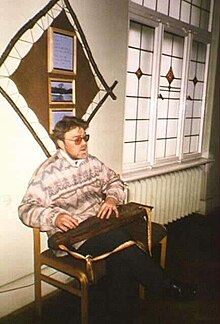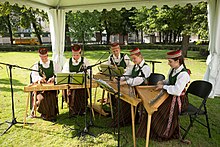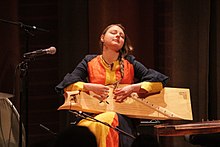 Different types of kokles made by Guntis Niedoliņš Different types of kokles made by Guntis Niedoliņš | |
| String instrument | |
|---|---|
| Other names | Kokle Kūkles, kūkļas, kūkļes, kūklis, kūkļis, kūkle, kūkļe, kūkla and kūkļa (Latgale) |
| Classification | Chordophone |
| Hornbostel–Sachs classification | 314.122-5 (Diatonic lute-type stringed instrument played using bare hands and fingers) |
| Inventor(s) | Folk instrument |
| Related instruments | |
| Kanklės, kannel, kantele, gusli | |
| Musicians | |
| Mārtiņš Baumanis, Nikolajs Heņķis [lv] (1864–1934), Namejs Kalniņš, Pēteris Korāts [lv] (1871–1957), Māris Muktupāvels, Valdis Muktupāvels, Biruta Ozoliņa [lv], Latvīte Podiņa, Laima Jansone [lv], Jānis Poriķis (1909–1992), Aloizijs Jūsmiņš [lv] (1915–1979; concert kokles) | |
| Builders | |
| Nikolajs Heņķis [lv] (1864–1934), Pēteris Korāts [lv] (1871–1957), Gunārs Igaunis [lv], Māris Jansons, Eduards Klints, Ģirts Laube, Krists Lazdiņš, Kārlis Lipors, Imants Robežnieks [lv] (concert kokles), Jānis Poriķis (1909–1992), Andris Roze, Jānis Rozenbergs, Rihards Valters, Edgars Vilmanis-Meženieks, Donāts Vucins [lv] (1934–1999) | |
Kokle (Latvian pronunciation: ['kʊ͡ɔk.le]; Latgalian: kūkle) or historically kokles (kūkles) is a Latvian plucked string instrument (chordophone) belonging to the Baltic box zither family known as the Baltic psaltery along with Lithuanian kanklės, Estonian kannel, Finnish kantele, and Russian krylovidnye gusli. The first possible kokles related archaeological findings in the territory of modern Latvia are from the 13th century, while the first reliable written information about kokles playing comes from the beginning of the 17th century. The first known kokles tune was notated in 1891, but the first kokles recordings into gramophone records and movies were made in the 1930s. Both kokles and kokles playing are included in the Latvian Culture Canon.
Etymology
According to Finnish linguist Eino Nieminen [fi], the name of the instrument, along with the names of most of its neighbouring counterparts (Lithuanian kanklės, Finnish kantele, Estonian kannel and Livonian kāndla), possibly comes from the proto-Baltic form *kantlīs/*kantlēs, which originally meant 'the singing tree', ultimately deriving from the Proto-European root *qan- ('to sing, to sound'). However, Lithuanian ethnologist Romualdas Apanavičius [lt] believes kokles could be derived from the Proto-European root *gan(dh)-, meaning 'a vessel; a haft (of a sword)', suggesting that it may be related to the Russian word gusli.
Construction
The kokles has a hollow trapezoidal body (ķermenis or korpuss) usually carved out of a single piece of wood (vienkocis) that's topped with a thin ornated wooden soundboard (skaņgaldiņš). A distinct feature that sets kokles apart from most of the other string instruments is that the strings don't rest on a bridge, making the sound quieter, but richer in timbre. Wooden (or sometimes metal) tuning pegs (tapas) are set into the wide tip of the body, while at the narrow tip is a metal rod (stīgturis) upon which the strings are secured, giving them a slightly fan-shaped arrangement. The strings may be of brass or steel. Traditionally, there were 6–9 strings which later increased to 10 and more.
Playing

The technique of kokles playing differs from most other plucked string instruments, including that of zither, harp and guitar. There are also some playing differences between the regional types of Latgale and Kurzeme instruments. In Kurzeme kokles was generally played while sitting on a stool, bench or chair without armrests and placing it horizontally in the lap with legs slightly parted. It could be played while laid on a table as well. For Latgale kokles the size and form of the instrument also allowed for it to be steadily placed in the lap in a vertical position, resting the shorter edge of kokles against the stomach and placing both arms on the instrument for extra comfort and stability.
Strumming is done with the index finger of the right hand while the left hand is used for muting unwanted strings by lightly placing fingers on them. An alternative string muting technique found in Latgale features the fingers being inserted in-between the strings, but such option heavily restricts the movement of the left arm. The left hand can also be used for picking strings.
Tuning
Tuning of the kokles is a diatonic scale, with some lower strings traditionally functioning as drones. A few traditional tuning variations include D-G-A-H-C for 5-stringed kokles written down by Andrejs Jurjāns at the end of the 19th century, D-C-D-E-F-G-A for 7-stringed kokles and D-C-D-E-F-G-A-H-C for 9-stringed kokles both used by traditional suiti kokles player Jānis Poriķis. However, as kokles began to be constructed with more strings and Latgale kokles became the dominant type of kokles among many other factors, the drone strings have gradually lost their function and become just a lower range extension of the kokles' diapason. Since the 1980s, the most popular tunings among kokles players for 11-stringed kokles are G-A-C-D-E-F-G-A-B-C (GA) and G-A-C-D-E-F-G-A-B♭-C (GA-b♭).
Types
In his book "The Baltic Psaltery and Playing Traditions in Latvia" (Kokles un koklēšana Latvijā) Latvian ethnomusicologist Valdis Muktupāvels distinguishes 3 types of traditional kokles – Kurzeme kokles (Kurzemes kokles), Latgale kokles (Latgales kokles) and zither kokles (cītarkokles) – and 3 types of modernised kokles – the so-called 15-stringed Krasnopjorovs'-Ķirpis' diatonic kokles (Krasnopjorova-Ķirpja diatoniskās kokles) and the concert kokles (koncertkokles) both designed in the Latvian SSR in 1940s to 1960s, as well as the so-called 13-stringed Linauts'-Dravnieks'-Jansons' kokles (Linauta-Dravnieka-Jansona kokles) that emerged in the Latvian American community in the 1960s.
Kurzeme kokles

In the Latvian historical region of Kurzeme kokles are traditionally constructed smaller in size and without a "wing", but with more ornate carvings and ornaments. It also usually has fewer strings than Latgale kokles, ranging from 5 to 6 stings for the ones found at the west coast of Kurzeme and Selonia to 7, 8 or even 9 strings for the suiti inhabited areas.
On May 17, 2015, during Latvia's presidency of the Council of the European Union, a Kurzeme kokles built by the crafter Jānis Rozenbergs was donated to the Musical Instruments Museum of Brussels.
Latgale kokles

In the largely Catholic Latgale region of Latvia, it was characteristic for the kokles to be constructed with an extension of the body beyond the peg line called a wing, that reinforces the sound of the instrument and can also be used as an arm support. Estonian ethnologist Igor Tõnurist believes that the wing may be a more recent innovation, that developed sometime before the 14th century for the Baltic psaltery played in the Pskov and Novgorod lands and later was borrowed by some neighbouring Baltic and Baltic Finnic people, such as Setos, Vepsians, and Latgalians. In comparison with Kurzeme kokles, the finish of Latgale kokles is less thorough; the instrument is bigger and heavier, with more strings (sometimes even up to 12 and only in rare cases less than 9) and with a more sober decoration.
In the Augšzeme-Vidzeme region both types of kokles, as well as mixed forms (for example, kokles with a small wing) were constructed.
Zither kokles
At the end of the 19th century and the beginning of the 20th century kokles traditions were influenced by the construction and playing style of the Western zithers coming from Germany and other Central European countries. Thus arose the so-called zither kokles: kokles with larger, zither-type cases, steel tuning pins, and an increased number of strings (from 17 to sometimes even up to 30 single or double strings).
Concert kokles

The first larger "concert kokle" with a three-and-a-half octave range and 25 stings was constructed in 1951 by Romāns Ķirpis for the Latvian folk music orchestra's soloist Helēna Kļava-Birgmeistere. It was the first to have devices for changing the pitches of strings in order to change keys. Few years later concert kokles saw a few more innovations in the construction and the new design gradually spread in the Latvian Conservatoire and musical schools, as well as amateur kokles ensembles.
For a long time, concert kokles were produced at the Musical Instrument Factory of Riga, mainly from leftover materials used for pianos. After Latvia regained its independence, the factory was closed and there were no dedicated kokles craftsmen until the mid-1990s. Soon, Imants Robežnieks [lv], who had previously worked at the factory, started making and fixing kokles again after receiving numerous requests from kokles players. Since then, he has been the only professional luthier of concert kokles in Latvia.
In mythology
Valdis Muktupāvels regards kokles as the most highly socially and economically valued Latvian instrument. Mythologically kokles may have been linked with the solar and celestial sphere as they are also sometimes called "Kokles of Dievs" (Dieva kokles) or "golden kokles" (zelta kokles) and sun ornaments were traditionally carved in the soundboard. Kokles, kokles playing (koklēšana) and kokles players (koklētāji) are mentioned in 274 Latvian dainas and mythological kokles players include Jānis [lv] and other unnamed sons of Dievs, as well as Saule playing kokles while sitting in the Austras koks.
In modern music


Already at the first kokles revival in the 1930s and 1940s kokles music saw an influx of newly composed folk music-inspired compositions and orchestral arrangements of folk songs. However, only recently has kokles truly grown to transcend the boundaries of traditional folk music. From the experimental post-folk band Iļģi [lv], Biruta Ozoliņa [lv]'s and DJ Monsta's electronic folk collaboration, Laima Jansone [lv]'s free improvisations and fusion of kokles' sounds with jazz in the project "Zarbugans" to a more heavier kokles-accompanied folk metal sound of Skyforger.
In 2002 record label Upe released a double CD by ethnomusicologist Valdis Muktupāvels titled "Kokles", dedicated to the instrument. The first disc "Muktukokles" contains 9 Muktupāvels' original kokles compositions and 2 arrangements of traditional songs accompanied by other instruments (sarod, tambura, and tabla), as well as the vocals of Rūta Muktupāvela [lv], while the second disc "Tradicionālās kokles" contains 24 Kurzeme, suiti and Latgale traditional tunes and dance melodies.
In 2016 record label Lauska released a CD Trejdeviņi koklētāji (Thrice-nine kokles players) featuring some of the best known Latvian kokles players (Valdis Muktupāvels, Laima Jansone [lv], Biruta Ozoliņa [lv] and Ansis Jansons among others) and Baltic psaltery players from abroad (Leanne Barbo [et; lv] from Estonia and Jenni Venäläinen [fi] from Finland), as well as Latvian concert kokles ensembles, with a collection of 13 compositions that span from traditional to ethno-jazz and ethno-baroque genres. A bilingual Latvian-English hardback booklet was also included with notes on performing musicians and their compositions, as well as a brief history of kokles.
References
- ^ Muktupāvels 2018, p. 141
- "Magic of Latvia's kokle showcased by young maestro". Public Broadcasting of Latvia. December 16, 2018. Retrieved December 17, 2018.
- Sheeter, Laura (October 29, 2005). "Latvia celebrates national instrument". BBC News. Retrieved March 30, 2017.
- ^ Muktupāvels, Valdis (1999). "Systematics of Latvian musical instruments" (in Latvian). Latvijas Mākslas augstskolu asociācija. pp. 96, 100–101. Archived from the original on November 9, 2005. Retrieved March 30, 2017.
Kokles, kokle (K; Z; V), kūkles (L), kūkle (L)
- ^ Broughton, Simon; Ellingham, Mark; Trillo, Richard, eds. (1999). World Music: Africa, Europe and the Middle East. The Rough Guide. pp. 16, 19–20 and 24. ISBN 978-1858-2863-5-8. Retrieved March 30, 2017.
Baltic psalteries variously called kantele, kannel, kokles or kanklės. (..) Kokles and citara. (...) The Latvian Baltic zither is called the kokle or kokles (...) it's usual to tune the lowest string of a kokles to a drone a fourth below the key note.
- ^ Peddie, Ian (2016). Popular Music and Human Rights: Volume II: World Music. Routledge. pp. 74, 82. ISBN 9781317078180. Retrieved March 30, 2017.
folk music instrument orchestras, and kokles ensembles (...) numerous kokle ensembles as well. The whole modernized kokle family (...) included appearance of kokle players
- Slobin, Mark (1993). Subcultural Sounds: Micromusics of the West. Apa Publications. p. 38. ISBN 978-0819-5626-1-6.
"revival" of the Latvian kokle zither (...) interact with the newly emerging kokle (...) the usefulness of kokle-playing
- Rice, Timothy; Porter, James; Goertzen, Chris, eds. (2017). The Garland Encyclopedia of World Music: Europe. Routledge. pp. 170, 503–504, 505. ISBN 978-1351-5442-6-9. Retrieved September 30, 2017.
The most characteristic and significant instrument in Latvian traditional music is the kokles, a board zither with five to twelve strings. (...) Small plucked zithers include the langeleik (Norway), the kantele (Finland), the kannel (Estonia), the kanklės (Lithuania), and the kokles (Latvia).
- Stone, Ruth M., ed. (2017). The Garland Encyclopedia of World Music: The World's Music: General Perspectives and Reference Tools. Routledge. p. 503. ISBN 978-1351-5441-1-5. Retrieved March 30, 2017.
kokles Latvian plucked zither, carved from a wooden plank and having five to twelve strings. (8)
- Djupsjöbacka, Tove (May 24, 2016). "The kantele – not exclusively Finnish". Finnish Music Quarterly. Retrieved May 24, 2017.
The official status of kanteles varies from one country to another. In the Baltic states, these instruments (the kannel in Estonia, the kokles in Latvia and the kanklės in Lithuania) have a firm official status.
- Cusack, Carole M.; Norman, Alex, eds. (2012). Handbook of New Religions and Cultural Production. Brill. pp. 351, 362–363. ISBN 978-9004-2218-7-1. Retrieved March 30, 2017.
The kanklės known in Latvia as the kokles, and has analogues in the kannel of Estonia, and the kanteles of Finland
- O'Connor, Kevin (2006). Culture and Customs of the Baltic States. Greenwood Publishing Group. pp. 176–177. ISBN 978-0313-3312-5-1. Retrieved March 30, 2017.
The most popular Baltic folk instrument is the board zither (psaltery), known as the kannel in Estonian, the kokles in Latvia and the kanklės in Lithuania. (..) the early kannel-kokles-kanklės was a five stringed instrument
- ^ Williams, Roger, ed. (1993). "The Singing Tree". Insight Guides: Baltic States. APA Publications (HK) Ltd. p. 85. ISBN 978-9624-2118-2-5. Retrieved March 30, 2017.
- Bousfield, Jonathan (2011). The Rough Guide to Estonia, Latvia & Lithuania (2nd ed.). Rough Guides. pp. 379 and 381. ISBN 978-1848-3688-8-0.
Baltic zithers variously called kantele, kannel, kokles or kankles.
- Williams, Roger; Hoefer, Hans (1993). Baltic States. Apa Publications. p. 85. ISBN 978-1848-3688-8-0.
The more sophisticated ones such as the kannel/kokles/kankles (...)
- Muktupāvels 2013, pp. 12–14
- Valdis Muktupāvels. "Kokles and kokles playing" (in Latvian). Latvian Culture Canon. Retrieved January 8, 2018.
- Romualdas Apanavičius. Ancient Lithuanian Kanklės, Institute of Ethnomusic, Vilnius, Lithuania
- Muktupāvels 2013, pp. 15–16
- ^ Muktupāvels 2013, pp. 41–42
- ^ Muktupāvels 2013, pp. 69–70
- Muktupāvels, Valdis (2009). "The small or the big kokles? A Shift of Preferences in the Context of the Folklore Revival Movement". Musiikin Suunta (1): 12. Retrieved March 30, 2017.
- Muktupāvels 2013, p. 90
- Muktupāvels 2013, p. 6
- Muktupāvels 2013, pp. 22–26
- Muktupāvels 2013, p. 15
- "Latvia donates kokle to the Musical Instruments Museum of Brussels". Ministry of Foreign Affairs of the Republic of Latvia. May 17, 2015. Retrieved March 30, 2017.
- Muktupāvels 2013, p. 17
- Muktupāvels 2018, p. 145
- Muktupāvels 2013, pp. 19–20
- Muktupāvels 2013, p. 240
- "Kokle master preserves 'the sound of a Latvian soul'". China Daily. November 4, 2005. Retrieved March 30, 2017.
- Strautmanis, Andris (September 10, 2001). "Iļģi not sure what to expect in America". Latvians Online. Retrieved March 30, 2017.
- Kaljo, Egils (October 27, 2013). "New release features Latvian folk songs with a twist". Latvians Online. Retrieved March 30, 2017.
- Kaljo, Egils (January 20, 2014). "Unique recording with Latvian instrumental music". Latvians Online. Retrieved March 30, 2017.
- Peeters, Tom (December 1, 2015). "Laima Jansone and her cool kokle". Bruzz. Retrieved March 30, 2017.
- Kvetkovskis, Pēteris (October 2, 2011). "Kokle". Skyforger. Retrieved March 30, 2017.
- Jātniece, Amanda (April 7, 2003). "Double album reveals range of Latvian kokle". Latvians Online. Retrieved March 30, 2017.
- Hanson, Jennifer (June 21, 2003). "Valdis Muktupavels, Kokles". Rambles. Retrieved March 30, 2017.
- Kaljo, Egils (October 15, 2016). "Various performers show diversity of "kokle" styles on new CD". Latvians Online. Retrieved March 30, 2017.
Bibliography
- Muktupāvels, Valdis (2013). The Baltic Psaltery and Playing Traditions in Latvia. Translated by Jātniece, Amanda (2nd ed.). Riga: Lauska. ISBN 978-9934-8276-2-4.
- Muktupāvels, Valdis (2018). Slišāne, Laura (ed.). Folk music instruments in Latvia. Translated by Damberga, Andra. The University of Latvia Press. ISBN 978-9934-1824-8-8.
Further reading
- Muktupāvels, Valdis. On some relations between kokles styles and contexts in the twentieth century. Journal of Baltic Studies, Vol. XXXI, No 4, Winter of 2000, pp. 388–405.
External links
- Koklēšana 21. gadsimtā / kokle play in the 21st century. The Ethnographic Open-Air Museum of Latvia. August 22, 2023.
- Kokle (in English) The Stringdom. November 15, 2017.
- Kokles playing studio "Kokļu mežs" (in Latvian)
- Videos of kokles playing methods, styles and reportoire (in Latvian)
- Song video tutorials for the book "Kokles dziesma dvēselei" (in Latvian)
| Latvian musical instruments | |
|---|---|
| Percussion | |
| String | |
| Wind | |
| Baltic psaltery | |
|---|---|
| Zithers | |||||||||
|---|---|---|---|---|---|---|---|---|---|
| By region |
| ||||||||
| Manufacturers | |||||||||